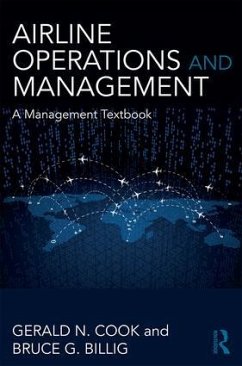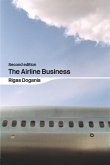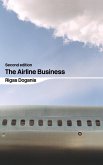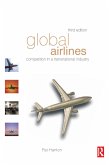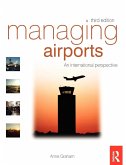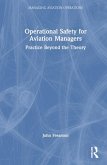- Broschiertes Buch
- Merkliste
- Auf die Merkliste
- Bewerten Bewerten
- Teilen
- Produkt teilen
- Produkterinnerung
- Produkterinnerung
Airline Operations and Management: A Management Textbook is a survey of the airline industry, mostly from a managerial perspective. It integrates and applies the fundamentals of several management disciplines, particularly economics, operations, marketing and finance, in developing the overview of the industry. The focus is on tactical, rather than strategic, management that is specialized or unique to the airline industry.
The primary audiences for this textbook are both senior and graduate students of airline management, but it should also be useful to entry and junior level airline…mehr
Andere Kunden interessierten sich auch für
![The Airline Business The Airline Business]() Rigas DoganisThe Airline Business74,99 €
Rigas DoganisThe Airline Business74,99 €![The Airline Business The Airline Business]() Rigas DoganisThe Airline Business271,99 €
Rigas DoganisThe Airline Business271,99 €![Global Airlines Global Airlines]() Pat HanlonGlobal Airlines197,99 €
Pat HanlonGlobal Airlines197,99 €![Managing Airports Managing Airports]() Anne GrahamManaging Airports77,99 €
Anne GrahamManaging Airports77,99 €![Beyond Airline Disruptions Beyond Airline Disruptions]() Jasenka RapajicBeyond Airline Disruptions197,99 €
Jasenka RapajicBeyond Airline Disruptions197,99 €![Operational Safety for Aviation Managers Operational Safety for Aviation Managers]() John FrearsonOperational Safety for Aviation Managers198,99 €
John FrearsonOperational Safety for Aviation Managers198,99 €![Tourism, Transport and Travel Management Tourism, Transport and Travel Management]() M. R. DileepTourism, Transport and Travel Management43,99 €
M. R. DileepTourism, Transport and Travel Management43,99 €-
-
-
Airline Operations and Management: A Management Textbook is a survey of the airline industry, mostly from a managerial perspective. It integrates and applies the fundamentals of several management disciplines, particularly economics, operations, marketing and finance, in developing the overview of the industry. The focus is on tactical, rather than strategic, management that is specialized or unique to the airline industry.
The primary audiences for this textbook are both senior and graduate students of airline management, but it should also be useful to entry and junior level airline managers and professionals seeking to expand their knowledge of the industry beyond their own functional area.
Hinweis: Dieser Artikel kann nur an eine deutsche Lieferadresse ausgeliefert werden.
The primary audiences for this textbook are both senior and graduate students of airline management, but it should also be useful to entry and junior level airline managers and professionals seeking to expand their knowledge of the industry beyond their own functional area.
Hinweis: Dieser Artikel kann nur an eine deutsche Lieferadresse ausgeliefert werden.
Produktdetails
- Produktdetails
- Verlag: Taylor & Francis
- Artikelnr. des Verlages: Y310281
- 1st ed.
- Seitenzahl: 344
- Erscheinungstermin: 15. Februar 2017
- Englisch
- Abmessung: 233mm x 154mm x 25mm
- Gewicht: 565g
- ISBN-13: 9781138237537
- ISBN-10: 1138237531
- Artikelnr.: 47350746
- Herstellerkennzeichnung
- Libri GmbH
- Europaallee 1
- 36244 Bad Hersfeld
- gpsr@libri.de
- Verlag: Taylor & Francis
- Artikelnr. des Verlages: Y310281
- 1st ed.
- Seitenzahl: 344
- Erscheinungstermin: 15. Februar 2017
- Englisch
- Abmessung: 233mm x 154mm x 25mm
- Gewicht: 565g
- ISBN-13: 9781138237537
- ISBN-10: 1138237531
- Artikelnr.: 47350746
- Herstellerkennzeichnung
- Libri GmbH
- Europaallee 1
- 36244 Bad Hersfeld
- gpsr@libri.de
Gerald N. Cook is Adjunct Professor in the College of Business at Embry-Riddle Aeronautical University. He obtained his Bachelor of Science in professional pilot technology and Master of Science in Management from Purdue University and Doctor of Business Administration from Nova Southeastern University. He enjoyed a long airline career as a pilot and in various flight operations management positions at several airlines. Dr. Cook is retired from Spirit Airlines. Bruce G. Billig is Adjunct Assistant Professor in the College of Aeronautics at Embry-Riddle Aeronautical University. He holds a Bachelor of Science in electrical engineering from the U.S. Air Force Academy and a Master of Aeronautical Science degree from Embry-Riddle. He retired from the Air Force as a Command Pilot in 1997 and is currently a captain in his 18th year at Southwest Airlines.
1. Historical Perspective 2. Supply and Demand for Air Transportation 3. Route Structure 4. Product Offering 5. Flight Schedule Development and Control 6. Economics and Finance 7. Pricing and Revenue Management 8. Distribution 9. International Air Transportation and Public Policy 10. Looking Ahead
Contents
List of Figures xii
List of Tables xvii
Introduction xviii
1 Historical Perspective 1
1.1 Transportation and Commerce 1
1.2 First Airlines 2
1.3 Early Regulation 3
1.4 History of British Airways 3
1.5 U.S. Air Mail 4
1.6 Economic Regulation 7
1.7 CAB Economic Regulation 1938 to 1978 8
1.8 Advances in Aircraft Technology 9
1.9 Post-War Airline Growth 11
1.10 The Jet Age 12
1.11 U.S. Deregulation 15
1.12 The Airline Deregulation Act of 1978 17
1.13 Post Deregulation Evolution 18
1.14 US Deregulation Results 18
1.15 CAB in Retrospect 19
1.16 Deregulation in Europe 20
1.17 Deregulation in China 21
1.18 Airline Industry Today 23
1.19 Summary 24
1.20 References 25
1.21 Review Questions 28
2 Supply and Demand for Air Transportation 30
2.1 Size, Scope and Economic Importance 30
2.2 Factors Driving Global Air Transportation Growth 32
2.3 Globalization 32
2.3.1 Demographics 33
2.3.2 Liberalization 35
2.3.3 Factors of Production 36
2.4 Air Cargo 36
2.5 Forecasting Air Travel Demand 37
2.5.1 Macro Forecasting 37
2.5.2 Route Level Micro Forecasting 40
2.6 Demand Curve 42
2.7 Need for Forecasts 47
2.8 New Route Example 47
2.9 Summary 50
2.10 References 52
2.11 Review Questions 54
3 Route Structure 55
3.1 History 55
3.2 Generic Route Structures 56
3.3 Point-to-Point 56
3.3.1 Fast, Cheap and Independent 56
3.3.1 Limited to Large Markets 57
3.3.2 Example: Ryanair 57
3.4 Linear 58
3.5 Hub-and-Spoke 60
3.5.1 Operation 60
3.5.2 Advantages 61
3.5.3 Disadvantages 64
3.5.4 Bottom Line 66
3.5.5 Examples of Hub-and-Spoke Route Systems 66
3.6 Hub-And-Spoke Variations 67
3.6.1 Hybrid Route Systems 67
3.6.2 Multiple Hubs 68
3.6.3 Directional Hub 69
3.6.4 Rolling Hub 71
3.6.5 Tailored Complexes 73
3.6.6 Legal, Financial, and Capacity Restrictions 74
3.7 Hub Airport Requisites 74
3.7.1 Competing H&S Systems 75
3.7.2 Hub Failures 76
3.8 Evolving Routes Systems 76
3.8.1 Southwest Airlines Route System 76
3.8.2 Delta's LaGuardia Hub 78
3.9 Summary 78
3.10 References 81
3.11 Review Questions 83
4 Product Offering 84
4.1 Strategic Choices 84
4.1.1The Marketing Concept 84
4.1.2 Generic Strategies 85
4.1.3 Industry Evaluation: Porter's Five Forces 86
4.2 Dimensions of Product Choice 88
4.3 Comprehensive Network Carriers 90
4.3.1 Differentiation 90
4.3.2 Delta Air Lines 92
4.4 Regional Airlines 92
4.4.1 Fleet 94
4.4.2 Network Extension 94
4.4.3 Regional Airlines Worldwide 96
4.4.4 Upheaval 96
4.5 Low-Cost-Carriers 97
4.5.1 Business Model 98
4.5.2 Ancillary Revenues 99
4.5.3 LCC Examples 100
4.5.5 Long-haul LCCs 101
4.5.6 LCC within Comprehensive Network Carriers 102
4.6 Hybrid Airlines 103
4.6.1 Alaska, JetBlue Airways, and Air Berlin 103
4.7 Focus Carriers and Tailored Products 105
4.7.1 All Inclusive Charter Airlines 105
4.7.2 All Business Class Service 106
4.7.3 Tailored Products 106
4.8 Cargo Airlines 107
4.8.1 Combination Carriers 108
4.8.2 Integrated Carriers 108
4.8.3 All Cargo Airlines 108
4.9 Summary 109
4.10 References 113
4.11 Review Questions 115
5 Flight Schedule Development and Control 116
5.1 Airline Planning Process 116
5.2 Strategic Planning 117
5.2.1 Long-Range Plan/Fleet Selection 117
5.2.2 Product Planning 117
5.3 Flight Schedule Development 118
5.3.1 Objectives 119
5.3.2 Fleet Assignment 122
5.3.3 Trade-offs 123
5.3.4 Optimization 123
5.3.5 The Passenger Service System 124
5.4 Asset Assignment 125
5.4.1 Aircraft Assignment 125
5.4.2 Aircraft Flow Chart 126
5.4.3 Crew Pairings and Bid Lines 127
5.5 Tactical Management 129
5.5.1 Airline Operations Control Center 129
5.5.2 Flight Schedule Disruptions 131
5.5.3 Managing Irregular Operations 131
5.5.4 Irregular Operations Examples 133
5.5.5 Dynamic Scheduling 134
5.6 Continuous Improvement 135
5.6.1 Goals 136
5.6.2 Measurement 136
5.6.3 Performance Diagnosis 137
5.6.4 Corrective Action 139
5.7 Summary 140
5.8 References 141
5.9 Review Questions 143
6 Economics and Finance 144
6.1 Profit History 144
6.1.1 Cyclical World Airline Profits 144
6.1.2 Net Profit Margin 145
6.1.3 Profits by World Region 146
6.1.4 Return on Invested Capital 147
6.2 Earning Profits 148
6.3 Revenue Generation 150
6.3.1 Yield History 150
6.3.2 Fare history 151
6.3.3 Revenue Passenger Miles 153
6.3.4 Ancillary Revenue 156
6.4 Cost Structure 159
6.4.1 Labor 160
6.4.2 Fuel 163
6.4.3 Ownership and Rental Expenses 166
6.4.4 Taxes 166
6.5 Legacy Carrier Restructuring 169
6.6 Fleet Selection 171
6.6.1 Range and Payload 171
6.6.2 Aircraft Operating Costs 172
6.7 Fleet Financing 176
6.7.1 Internal Financing 176
6.7.2 Debt Financing 177
6.7.3 Leasing 177
6.7.4 Financing Portfolio 179
6.8 Economics of Scale, Scope and Density 179
6.8.1 Scale 180
6.8.2 Density 180
6.8.3 Scope 180
6.9 Summary 181
6.10 References 182
6.11 Review Questions 186
7 Pricing and Revenue Management 187
7.1 Regulated Prices 187
7.2 Objective of Revenue Management 188
7.3 Revenue Management Components 189
7.3.1 Overbooking 189 7.3.2 Overselling 191
7.4 Pricing 194
7.5 Revenue Management Product Characteristics 194
7.5.1 Seat Allocation 195
7.5.2 Price Discrimination 198
7.5.3 Market Segmentation 199 7.5.4 Estimating Demand 201
7.5.5 Fare Buckets and Fare Nesting 206
7.5.6 Expected Booking Updating 208
7.5.7 Selling-Up 209 7.5.8 Revenue Enhancement with Revenue Management 210
7.6 Network Allocation 210
7.6.1 Hidden City Ticketing 214
7.7 Revenue Management in Air Freight 214
7.8 The Future of Revenue Management 215
7.9 Summary 216
7.10 References 217
7.11 Review Questions 220
8 Distribution 221
8.1 Airline Distribution History 222
8.1.1 The OAG 223
8.1.2 Payment 224
8.1.3 Ticketing 224
8.1.4 The Growth of Travel Agencies 226
8.1.5 The Reservisor 227
8.1.6 The Magnetronic Reservisor 228
8.1.7 Reserwriter 230
8.1.8 SABER 230
8.1.9 Travel Agents Get Involved 232
8.2 The Birth of the Global Distribution System 234
8.2.1 CRS Favoritism 235
8.2.2 GDS Regulation 236
8.3 GDS Mergers, Consolidation and Sell-Off 238
8.3.1 European Connections 239
8.3.2 Deregulation 241
8.4 The Rise of the Internet Changes the GDS Environment 243
8.4.1 Airline Internal Reservations Systems 245
8.4.2 Shift in Travel Agency Approach 245
8.5 The Rise of Online Travel Agencies 247
8.5.1 Standard Online Travel Services 247
8.5.2 Opaque Travel Services 249
8.5.3 Fare Aggregators and Metasearch Engines 251
8.5.4 Travel Agents Using GDS Alternatives 251
8.6 New Distribution Capability 252
8.6.1 Airline Perspective
8.6.2 GDS Perspective
8.7 Summary 254
8.8 References 257
8.9 Review Questions 262
9 International Air Transportation and Public Policy 263
9.1 Air Service Agreements 263
9.2 Open Skies 264
9.2.1 US Open Skies 264
9.2.2 EU Open Skies 267
9.2.3 Air Service Liberalization Support and Opposition 267
9.3 State-Owned Airlines 268
9.4 Global Alliances 271
9.4.1 History of the Big 3 Global Airline Alliances 271
9.4.2 Marketing and Revenue Benefits 274
9.4.3 Operating Benefits 274
9.4.4 Antitrust Immunity 274
9.4.5 Establishing an Alliance 275
9.4.6 Passenger Benefits 277
9.4.7 Alliance Instability 277
9.4.8 Equity Alliance 278
9.5 Consolidation - Mergers and Acquisitions 279
9.6 Conclusion 280
9.7 References 281
9.8 Review Questions 283
10 Looking Ahead 285
10.1 Cyclical Profits 285
10.1.1 Fixed Cost 286
10.1.2 Fuel Expenses 286
10.1.3 Cost Control 286
10.1.4 Airline Failure and Restructuring 286
10.2 Environmental Regulation and Cost 287
10.3 Turmoil in Distribution 287
10.4 Complex Airline Structures 288
10.5 Governance 289
10.6 Evolving Airline Strategies 290
10.6.1 Business Model Evolution 290
10.6.2 Emerging Models 291
10.7 Still Fragmented 292
List of Figures xii
List of Tables xvii
Introduction xviii
1 Historical Perspective 1
1.1 Transportation and Commerce 1
1.2 First Airlines 2
1.3 Early Regulation 3
1.4 History of British Airways 3
1.5 U.S. Air Mail 4
1.6 Economic Regulation 7
1.7 CAB Economic Regulation 1938 to 1978 8
1.8 Advances in Aircraft Technology 9
1.9 Post-War Airline Growth 11
1.10 The Jet Age 12
1.11 U.S. Deregulation 15
1.12 The Airline Deregulation Act of 1978 17
1.13 Post Deregulation Evolution 18
1.14 US Deregulation Results 18
1.15 CAB in Retrospect 19
1.16 Deregulation in Europe 20
1.17 Deregulation in China 21
1.18 Airline Industry Today 23
1.19 Summary 24
1.20 References 25
1.21 Review Questions 28
2 Supply and Demand for Air Transportation 30
2.1 Size, Scope and Economic Importance 30
2.2 Factors Driving Global Air Transportation Growth 32
2.3 Globalization 32
2.3.1 Demographics 33
2.3.2 Liberalization 35
2.3.3 Factors of Production 36
2.4 Air Cargo 36
2.5 Forecasting Air Travel Demand 37
2.5.1 Macro Forecasting 37
2.5.2 Route Level Micro Forecasting 40
2.6 Demand Curve 42
2.7 Need for Forecasts 47
2.8 New Route Example 47
2.9 Summary 50
2.10 References 52
2.11 Review Questions 54
3 Route Structure 55
3.1 History 55
3.2 Generic Route Structures 56
3.3 Point-to-Point 56
3.3.1 Fast, Cheap and Independent 56
3.3.1 Limited to Large Markets 57
3.3.2 Example: Ryanair 57
3.4 Linear 58
3.5 Hub-and-Spoke 60
3.5.1 Operation 60
3.5.2 Advantages 61
3.5.3 Disadvantages 64
3.5.4 Bottom Line 66
3.5.5 Examples of Hub-and-Spoke Route Systems 66
3.6 Hub-And-Spoke Variations 67
3.6.1 Hybrid Route Systems 67
3.6.2 Multiple Hubs 68
3.6.3 Directional Hub 69
3.6.4 Rolling Hub 71
3.6.5 Tailored Complexes 73
3.6.6 Legal, Financial, and Capacity Restrictions 74
3.7 Hub Airport Requisites 74
3.7.1 Competing H&S Systems 75
3.7.2 Hub Failures 76
3.8 Evolving Routes Systems 76
3.8.1 Southwest Airlines Route System 76
3.8.2 Delta's LaGuardia Hub 78
3.9 Summary 78
3.10 References 81
3.11 Review Questions 83
4 Product Offering 84
4.1 Strategic Choices 84
4.1.1The Marketing Concept 84
4.1.2 Generic Strategies 85
4.1.3 Industry Evaluation: Porter's Five Forces 86
4.2 Dimensions of Product Choice 88
4.3 Comprehensive Network Carriers 90
4.3.1 Differentiation 90
4.3.2 Delta Air Lines 92
4.4 Regional Airlines 92
4.4.1 Fleet 94
4.4.2 Network Extension 94
4.4.3 Regional Airlines Worldwide 96
4.4.4 Upheaval 96
4.5 Low-Cost-Carriers 97
4.5.1 Business Model 98
4.5.2 Ancillary Revenues 99
4.5.3 LCC Examples 100
4.5.5 Long-haul LCCs 101
4.5.6 LCC within Comprehensive Network Carriers 102
4.6 Hybrid Airlines 103
4.6.1 Alaska, JetBlue Airways, and Air Berlin 103
4.7 Focus Carriers and Tailored Products 105
4.7.1 All Inclusive Charter Airlines 105
4.7.2 All Business Class Service 106
4.7.3 Tailored Products 106
4.8 Cargo Airlines 107
4.8.1 Combination Carriers 108
4.8.2 Integrated Carriers 108
4.8.3 All Cargo Airlines 108
4.9 Summary 109
4.10 References 113
4.11 Review Questions 115
5 Flight Schedule Development and Control 116
5.1 Airline Planning Process 116
5.2 Strategic Planning 117
5.2.1 Long-Range Plan/Fleet Selection 117
5.2.2 Product Planning 117
5.3 Flight Schedule Development 118
5.3.1 Objectives 119
5.3.2 Fleet Assignment 122
5.3.3 Trade-offs 123
5.3.4 Optimization 123
5.3.5 The Passenger Service System 124
5.4 Asset Assignment 125
5.4.1 Aircraft Assignment 125
5.4.2 Aircraft Flow Chart 126
5.4.3 Crew Pairings and Bid Lines 127
5.5 Tactical Management 129
5.5.1 Airline Operations Control Center 129
5.5.2 Flight Schedule Disruptions 131
5.5.3 Managing Irregular Operations 131
5.5.4 Irregular Operations Examples 133
5.5.5 Dynamic Scheduling 134
5.6 Continuous Improvement 135
5.6.1 Goals 136
5.6.2 Measurement 136
5.6.3 Performance Diagnosis 137
5.6.4 Corrective Action 139
5.7 Summary 140
5.8 References 141
5.9 Review Questions 143
6 Economics and Finance 144
6.1 Profit History 144
6.1.1 Cyclical World Airline Profits 144
6.1.2 Net Profit Margin 145
6.1.3 Profits by World Region 146
6.1.4 Return on Invested Capital 147
6.2 Earning Profits 148
6.3 Revenue Generation 150
6.3.1 Yield History 150
6.3.2 Fare history 151
6.3.3 Revenue Passenger Miles 153
6.3.4 Ancillary Revenue 156
6.4 Cost Structure 159
6.4.1 Labor 160
6.4.2 Fuel 163
6.4.3 Ownership and Rental Expenses 166
6.4.4 Taxes 166
6.5 Legacy Carrier Restructuring 169
6.6 Fleet Selection 171
6.6.1 Range and Payload 171
6.6.2 Aircraft Operating Costs 172
6.7 Fleet Financing 176
6.7.1 Internal Financing 176
6.7.2 Debt Financing 177
6.7.3 Leasing 177
6.7.4 Financing Portfolio 179
6.8 Economics of Scale, Scope and Density 179
6.8.1 Scale 180
6.8.2 Density 180
6.8.3 Scope 180
6.9 Summary 181
6.10 References 182
6.11 Review Questions 186
7 Pricing and Revenue Management 187
7.1 Regulated Prices 187
7.2 Objective of Revenue Management 188
7.3 Revenue Management Components 189
7.3.1 Overbooking 189 7.3.2 Overselling 191
7.4 Pricing 194
7.5 Revenue Management Product Characteristics 194
7.5.1 Seat Allocation 195
7.5.2 Price Discrimination 198
7.5.3 Market Segmentation 199 7.5.4 Estimating Demand 201
7.5.5 Fare Buckets and Fare Nesting 206
7.5.6 Expected Booking Updating 208
7.5.7 Selling-Up 209 7.5.8 Revenue Enhancement with Revenue Management 210
7.6 Network Allocation 210
7.6.1 Hidden City Ticketing 214
7.7 Revenue Management in Air Freight 214
7.8 The Future of Revenue Management 215
7.9 Summary 216
7.10 References 217
7.11 Review Questions 220
8 Distribution 221
8.1 Airline Distribution History 222
8.1.1 The OAG 223
8.1.2 Payment 224
8.1.3 Ticketing 224
8.1.4 The Growth of Travel Agencies 226
8.1.5 The Reservisor 227
8.1.6 The Magnetronic Reservisor 228
8.1.7 Reserwriter 230
8.1.8 SABER 230
8.1.9 Travel Agents Get Involved 232
8.2 The Birth of the Global Distribution System 234
8.2.1 CRS Favoritism 235
8.2.2 GDS Regulation 236
8.3 GDS Mergers, Consolidation and Sell-Off 238
8.3.1 European Connections 239
8.3.2 Deregulation 241
8.4 The Rise of the Internet Changes the GDS Environment 243
8.4.1 Airline Internal Reservations Systems 245
8.4.2 Shift in Travel Agency Approach 245
8.5 The Rise of Online Travel Agencies 247
8.5.1 Standard Online Travel Services 247
8.5.2 Opaque Travel Services 249
8.5.3 Fare Aggregators and Metasearch Engines 251
8.5.4 Travel Agents Using GDS Alternatives 251
8.6 New Distribution Capability 252
8.6.1 Airline Perspective
8.6.2 GDS Perspective
8.7 Summary 254
8.8 References 257
8.9 Review Questions 262
9 International Air Transportation and Public Policy 263
9.1 Air Service Agreements 263
9.2 Open Skies 264
9.2.1 US Open Skies 264
9.2.2 EU Open Skies 267
9.2.3 Air Service Liberalization Support and Opposition 267
9.3 State-Owned Airlines 268
9.4 Global Alliances 271
9.4.1 History of the Big 3 Global Airline Alliances 271
9.4.2 Marketing and Revenue Benefits 274
9.4.3 Operating Benefits 274
9.4.4 Antitrust Immunity 274
9.4.5 Establishing an Alliance 275
9.4.6 Passenger Benefits 277
9.4.7 Alliance Instability 277
9.4.8 Equity Alliance 278
9.5 Consolidation - Mergers and Acquisitions 279
9.6 Conclusion 280
9.7 References 281
9.8 Review Questions 283
10 Looking Ahead 285
10.1 Cyclical Profits 285
10.1.1 Fixed Cost 286
10.1.2 Fuel Expenses 286
10.1.3 Cost Control 286
10.1.4 Airline Failure and Restructuring 286
10.2 Environmental Regulation and Cost 287
10.3 Turmoil in Distribution 287
10.4 Complex Airline Structures 288
10.5 Governance 289
10.6 Evolving Airline Strategies 290
10.6.1 Business Model Evolution 290
10.6.2 Emerging Models 291
10.7 Still Fragmented 292
1. Historical Perspective 2. Supply and Demand for Air Transportation 3. Route Structure 4. Product Offering 5. Flight Schedule Development and Control 6. Economics and Finance 7. Pricing and Revenue Management 8. Distribution 9. International Air Transportation and Public Policy 10. Looking Ahead
Contents
List of Figures xii
List of Tables xvii
Introduction xviii
1 Historical Perspective 1
1.1 Transportation and Commerce 1
1.2 First Airlines 2
1.3 Early Regulation 3
1.4 History of British Airways 3
1.5 U.S. Air Mail 4
1.6 Economic Regulation 7
1.7 CAB Economic Regulation 1938 to 1978 8
1.8 Advances in Aircraft Technology 9
1.9 Post-War Airline Growth 11
1.10 The Jet Age 12
1.11 U.S. Deregulation 15
1.12 The Airline Deregulation Act of 1978 17
1.13 Post Deregulation Evolution 18
1.14 US Deregulation Results 18
1.15 CAB in Retrospect 19
1.16 Deregulation in Europe 20
1.17 Deregulation in China 21
1.18 Airline Industry Today 23
1.19 Summary 24
1.20 References 25
1.21 Review Questions 28
2 Supply and Demand for Air Transportation 30
2.1 Size, Scope and Economic Importance 30
2.2 Factors Driving Global Air Transportation Growth 32
2.3 Globalization 32
2.3.1 Demographics 33
2.3.2 Liberalization 35
2.3.3 Factors of Production 36
2.4 Air Cargo 36
2.5 Forecasting Air Travel Demand 37
2.5.1 Macro Forecasting 37
2.5.2 Route Level Micro Forecasting 40
2.6 Demand Curve 42
2.7 Need for Forecasts 47
2.8 New Route Example 47
2.9 Summary 50
2.10 References 52
2.11 Review Questions 54
3 Route Structure 55
3.1 History 55
3.2 Generic Route Structures 56
3.3 Point-to-Point 56
3.3.1 Fast, Cheap and Independent 56
3.3.1 Limited to Large Markets 57
3.3.2 Example: Ryanair 57
3.4 Linear 58
3.5 Hub-and-Spoke 60
3.5.1 Operation 60
3.5.2 Advantages 61
3.5.3 Disadvantages 64
3.5.4 Bottom Line 66
3.5.5 Examples of Hub-and-Spoke Route Systems 66
3.6 Hub-And-Spoke Variations 67
3.6.1 Hybrid Route Systems 67
3.6.2 Multiple Hubs 68
3.6.3 Directional Hub 69
3.6.4 Rolling Hub 71
3.6.5 Tailored Complexes 73
3.6.6 Legal, Financial, and Capacity Restrictions 74
3.7 Hub Airport Requisites 74
3.7.1 Competing H&S Systems 75
3.7.2 Hub Failures 76
3.8 Evolving Routes Systems 76
3.8.1 Southwest Airlines Route System 76
3.8.2 Delta's LaGuardia Hub 78
3.9 Summary 78
3.10 References 81
3.11 Review Questions 83
4 Product Offering 84
4.1 Strategic Choices 84
4.1.1The Marketing Concept 84
4.1.2 Generic Strategies 85
4.1.3 Industry Evaluation: Porter's Five Forces 86
4.2 Dimensions of Product Choice 88
4.3 Comprehensive Network Carriers 90
4.3.1 Differentiation 90
4.3.2 Delta Air Lines 92
4.4 Regional Airlines 92
4.4.1 Fleet 94
4.4.2 Network Extension 94
4.4.3 Regional Airlines Worldwide 96
4.4.4 Upheaval 96
4.5 Low-Cost-Carriers 97
4.5.1 Business Model 98
4.5.2 Ancillary Revenues 99
4.5.3 LCC Examples 100
4.5.5 Long-haul LCCs 101
4.5.6 LCC within Comprehensive Network Carriers 102
4.6 Hybrid Airlines 103
4.6.1 Alaska, JetBlue Airways, and Air Berlin 103
4.7 Focus Carriers and Tailored Products 105
4.7.1 All Inclusive Charter Airlines 105
4.7.2 All Business Class Service 106
4.7.3 Tailored Products 106
4.8 Cargo Airlines 107
4.8.1 Combination Carriers 108
4.8.2 Integrated Carriers 108
4.8.3 All Cargo Airlines 108
4.9 Summary 109
4.10 References 113
4.11 Review Questions 115
5 Flight Schedule Development and Control 116
5.1 Airline Planning Process 116
5.2 Strategic Planning 117
5.2.1 Long-Range Plan/Fleet Selection 117
5.2.2 Product Planning 117
5.3 Flight Schedule Development 118
5.3.1 Objectives 119
5.3.2 Fleet Assignment 122
5.3.3 Trade-offs 123
5.3.4 Optimization 123
5.3.5 The Passenger Service System 124
5.4 Asset Assignment 125
5.4.1 Aircraft Assignment 125
5.4.2 Aircraft Flow Chart 126
5.4.3 Crew Pairings and Bid Lines 127
5.5 Tactical Management 129
5.5.1 Airline Operations Control Center 129
5.5.2 Flight Schedule Disruptions 131
5.5.3 Managing Irregular Operations 131
5.5.4 Irregular Operations Examples 133
5.5.5 Dynamic Scheduling 134
5.6 Continuous Improvement 135
5.6.1 Goals 136
5.6.2 Measurement 136
5.6.3 Performance Diagnosis 137
5.6.4 Corrective Action 139
5.7 Summary 140
5.8 References 141
5.9 Review Questions 143
6 Economics and Finance 144
6.1 Profit History 144
6.1.1 Cyclical World Airline Profits 144
6.1.2 Net Profit Margin 145
6.1.3 Profits by World Region 146
6.1.4 Return on Invested Capital 147
6.2 Earning Profits 148
6.3 Revenue Generation 150
6.3.1 Yield History 150
6.3.2 Fare history 151
6.3.3 Revenue Passenger Miles 153
6.3.4 Ancillary Revenue 156
6.4 Cost Structure 159
6.4.1 Labor 160
6.4.2 Fuel 163
6.4.3 Ownership and Rental Expenses 166
6.4.4 Taxes 166
6.5 Legacy Carrier Restructuring 169
6.6 Fleet Selection 171
6.6.1 Range and Payload 171
6.6.2 Aircraft Operating Costs 172
6.7 Fleet Financing 176
6.7.1 Internal Financing 176
6.7.2 Debt Financing 177
6.7.3 Leasing 177
6.7.4 Financing Portfolio 179
6.8 Economics of Scale, Scope and Density 179
6.8.1 Scale 180
6.8.2 Density 180
6.8.3 Scope 180
6.9 Summary 181
6.10 References 182
6.11 Review Questions 186
7 Pricing and Revenue Management 187
7.1 Regulated Prices 187
7.2 Objective of Revenue Management 188
7.3 Revenue Management Components 189
7.3.1 Overbooking 189 7.3.2 Overselling 191
7.4 Pricing 194
7.5 Revenue Management Product Characteristics 194
7.5.1 Seat Allocation 195
7.5.2 Price Discrimination 198
7.5.3 Market Segmentation 199 7.5.4 Estimating Demand 201
7.5.5 Fare Buckets and Fare Nesting 206
7.5.6 Expected Booking Updating 208
7.5.7 Selling-Up 209 7.5.8 Revenue Enhancement with Revenue Management 210
7.6 Network Allocation 210
7.6.1 Hidden City Ticketing 214
7.7 Revenue Management in Air Freight 214
7.8 The Future of Revenue Management 215
7.9 Summary 216
7.10 References 217
7.11 Review Questions 220
8 Distribution 221
8.1 Airline Distribution History 222
8.1.1 The OAG 223
8.1.2 Payment 224
8.1.3 Ticketing 224
8.1.4 The Growth of Travel Agencies 226
8.1.5 The Reservisor 227
8.1.6 The Magnetronic Reservisor 228
8.1.7 Reserwriter 230
8.1.8 SABER 230
8.1.9 Travel Agents Get Involved 232
8.2 The Birth of the Global Distribution System 234
8.2.1 CRS Favoritism 235
8.2.2 GDS Regulation 236
8.3 GDS Mergers, Consolidation and Sell-Off 238
8.3.1 European Connections 239
8.3.2 Deregulation 241
8.4 The Rise of the Internet Changes the GDS Environment 243
8.4.1 Airline Internal Reservations Systems 245
8.4.2 Shift in Travel Agency Approach 245
8.5 The Rise of Online Travel Agencies 247
8.5.1 Standard Online Travel Services 247
8.5.2 Opaque Travel Services 249
8.5.3 Fare Aggregators and Metasearch Engines 251
8.5.4 Travel Agents Using GDS Alternatives 251
8.6 New Distribution Capability 252
8.6.1 Airline Perspective
8.6.2 GDS Perspective
8.7 Summary 254
8.8 References 257
8.9 Review Questions 262
9 International Air Transportation and Public Policy 263
9.1 Air Service Agreements 263
9.2 Open Skies 264
9.2.1 US Open Skies 264
9.2.2 EU Open Skies 267
9.2.3 Air Service Liberalization Support and Opposition 267
9.3 State-Owned Airlines 268
9.4 Global Alliances 271
9.4.1 History of the Big 3 Global Airline Alliances 271
9.4.2 Marketing and Revenue Benefits 274
9.4.3 Operating Benefits 274
9.4.4 Antitrust Immunity 274
9.4.5 Establishing an Alliance 275
9.4.6 Passenger Benefits 277
9.4.7 Alliance Instability 277
9.4.8 Equity Alliance 278
9.5 Consolidation - Mergers and Acquisitions 279
9.6 Conclusion 280
9.7 References 281
9.8 Review Questions 283
10 Looking Ahead 285
10.1 Cyclical Profits 285
10.1.1 Fixed Cost 286
10.1.2 Fuel Expenses 286
10.1.3 Cost Control 286
10.1.4 Airline Failure and Restructuring 286
10.2 Environmental Regulation and Cost 287
10.3 Turmoil in Distribution 287
10.4 Complex Airline Structures 288
10.5 Governance 289
10.6 Evolving Airline Strategies 290
10.6.1 Business Model Evolution 290
10.6.2 Emerging Models 291
10.7 Still Fragmented 292
List of Figures xii
List of Tables xvii
Introduction xviii
1 Historical Perspective 1
1.1 Transportation and Commerce 1
1.2 First Airlines 2
1.3 Early Regulation 3
1.4 History of British Airways 3
1.5 U.S. Air Mail 4
1.6 Economic Regulation 7
1.7 CAB Economic Regulation 1938 to 1978 8
1.8 Advances in Aircraft Technology 9
1.9 Post-War Airline Growth 11
1.10 The Jet Age 12
1.11 U.S. Deregulation 15
1.12 The Airline Deregulation Act of 1978 17
1.13 Post Deregulation Evolution 18
1.14 US Deregulation Results 18
1.15 CAB in Retrospect 19
1.16 Deregulation in Europe 20
1.17 Deregulation in China 21
1.18 Airline Industry Today 23
1.19 Summary 24
1.20 References 25
1.21 Review Questions 28
2 Supply and Demand for Air Transportation 30
2.1 Size, Scope and Economic Importance 30
2.2 Factors Driving Global Air Transportation Growth 32
2.3 Globalization 32
2.3.1 Demographics 33
2.3.2 Liberalization 35
2.3.3 Factors of Production 36
2.4 Air Cargo 36
2.5 Forecasting Air Travel Demand 37
2.5.1 Macro Forecasting 37
2.5.2 Route Level Micro Forecasting 40
2.6 Demand Curve 42
2.7 Need for Forecasts 47
2.8 New Route Example 47
2.9 Summary 50
2.10 References 52
2.11 Review Questions 54
3 Route Structure 55
3.1 History 55
3.2 Generic Route Structures 56
3.3 Point-to-Point 56
3.3.1 Fast, Cheap and Independent 56
3.3.1 Limited to Large Markets 57
3.3.2 Example: Ryanair 57
3.4 Linear 58
3.5 Hub-and-Spoke 60
3.5.1 Operation 60
3.5.2 Advantages 61
3.5.3 Disadvantages 64
3.5.4 Bottom Line 66
3.5.5 Examples of Hub-and-Spoke Route Systems 66
3.6 Hub-And-Spoke Variations 67
3.6.1 Hybrid Route Systems 67
3.6.2 Multiple Hubs 68
3.6.3 Directional Hub 69
3.6.4 Rolling Hub 71
3.6.5 Tailored Complexes 73
3.6.6 Legal, Financial, and Capacity Restrictions 74
3.7 Hub Airport Requisites 74
3.7.1 Competing H&S Systems 75
3.7.2 Hub Failures 76
3.8 Evolving Routes Systems 76
3.8.1 Southwest Airlines Route System 76
3.8.2 Delta's LaGuardia Hub 78
3.9 Summary 78
3.10 References 81
3.11 Review Questions 83
4 Product Offering 84
4.1 Strategic Choices 84
4.1.1The Marketing Concept 84
4.1.2 Generic Strategies 85
4.1.3 Industry Evaluation: Porter's Five Forces 86
4.2 Dimensions of Product Choice 88
4.3 Comprehensive Network Carriers 90
4.3.1 Differentiation 90
4.3.2 Delta Air Lines 92
4.4 Regional Airlines 92
4.4.1 Fleet 94
4.4.2 Network Extension 94
4.4.3 Regional Airlines Worldwide 96
4.4.4 Upheaval 96
4.5 Low-Cost-Carriers 97
4.5.1 Business Model 98
4.5.2 Ancillary Revenues 99
4.5.3 LCC Examples 100
4.5.5 Long-haul LCCs 101
4.5.6 LCC within Comprehensive Network Carriers 102
4.6 Hybrid Airlines 103
4.6.1 Alaska, JetBlue Airways, and Air Berlin 103
4.7 Focus Carriers and Tailored Products 105
4.7.1 All Inclusive Charter Airlines 105
4.7.2 All Business Class Service 106
4.7.3 Tailored Products 106
4.8 Cargo Airlines 107
4.8.1 Combination Carriers 108
4.8.2 Integrated Carriers 108
4.8.3 All Cargo Airlines 108
4.9 Summary 109
4.10 References 113
4.11 Review Questions 115
5 Flight Schedule Development and Control 116
5.1 Airline Planning Process 116
5.2 Strategic Planning 117
5.2.1 Long-Range Plan/Fleet Selection 117
5.2.2 Product Planning 117
5.3 Flight Schedule Development 118
5.3.1 Objectives 119
5.3.2 Fleet Assignment 122
5.3.3 Trade-offs 123
5.3.4 Optimization 123
5.3.5 The Passenger Service System 124
5.4 Asset Assignment 125
5.4.1 Aircraft Assignment 125
5.4.2 Aircraft Flow Chart 126
5.4.3 Crew Pairings and Bid Lines 127
5.5 Tactical Management 129
5.5.1 Airline Operations Control Center 129
5.5.2 Flight Schedule Disruptions 131
5.5.3 Managing Irregular Operations 131
5.5.4 Irregular Operations Examples 133
5.5.5 Dynamic Scheduling 134
5.6 Continuous Improvement 135
5.6.1 Goals 136
5.6.2 Measurement 136
5.6.3 Performance Diagnosis 137
5.6.4 Corrective Action 139
5.7 Summary 140
5.8 References 141
5.9 Review Questions 143
6 Economics and Finance 144
6.1 Profit History 144
6.1.1 Cyclical World Airline Profits 144
6.1.2 Net Profit Margin 145
6.1.3 Profits by World Region 146
6.1.4 Return on Invested Capital 147
6.2 Earning Profits 148
6.3 Revenue Generation 150
6.3.1 Yield History 150
6.3.2 Fare history 151
6.3.3 Revenue Passenger Miles 153
6.3.4 Ancillary Revenue 156
6.4 Cost Structure 159
6.4.1 Labor 160
6.4.2 Fuel 163
6.4.3 Ownership and Rental Expenses 166
6.4.4 Taxes 166
6.5 Legacy Carrier Restructuring 169
6.6 Fleet Selection 171
6.6.1 Range and Payload 171
6.6.2 Aircraft Operating Costs 172
6.7 Fleet Financing 176
6.7.1 Internal Financing 176
6.7.2 Debt Financing 177
6.7.3 Leasing 177
6.7.4 Financing Portfolio 179
6.8 Economics of Scale, Scope and Density 179
6.8.1 Scale 180
6.8.2 Density 180
6.8.3 Scope 180
6.9 Summary 181
6.10 References 182
6.11 Review Questions 186
7 Pricing and Revenue Management 187
7.1 Regulated Prices 187
7.2 Objective of Revenue Management 188
7.3 Revenue Management Components 189
7.3.1 Overbooking 189 7.3.2 Overselling 191
7.4 Pricing 194
7.5 Revenue Management Product Characteristics 194
7.5.1 Seat Allocation 195
7.5.2 Price Discrimination 198
7.5.3 Market Segmentation 199 7.5.4 Estimating Demand 201
7.5.5 Fare Buckets and Fare Nesting 206
7.5.6 Expected Booking Updating 208
7.5.7 Selling-Up 209 7.5.8 Revenue Enhancement with Revenue Management 210
7.6 Network Allocation 210
7.6.1 Hidden City Ticketing 214
7.7 Revenue Management in Air Freight 214
7.8 The Future of Revenue Management 215
7.9 Summary 216
7.10 References 217
7.11 Review Questions 220
8 Distribution 221
8.1 Airline Distribution History 222
8.1.1 The OAG 223
8.1.2 Payment 224
8.1.3 Ticketing 224
8.1.4 The Growth of Travel Agencies 226
8.1.5 The Reservisor 227
8.1.6 The Magnetronic Reservisor 228
8.1.7 Reserwriter 230
8.1.8 SABER 230
8.1.9 Travel Agents Get Involved 232
8.2 The Birth of the Global Distribution System 234
8.2.1 CRS Favoritism 235
8.2.2 GDS Regulation 236
8.3 GDS Mergers, Consolidation and Sell-Off 238
8.3.1 European Connections 239
8.3.2 Deregulation 241
8.4 The Rise of the Internet Changes the GDS Environment 243
8.4.1 Airline Internal Reservations Systems 245
8.4.2 Shift in Travel Agency Approach 245
8.5 The Rise of Online Travel Agencies 247
8.5.1 Standard Online Travel Services 247
8.5.2 Opaque Travel Services 249
8.5.3 Fare Aggregators and Metasearch Engines 251
8.5.4 Travel Agents Using GDS Alternatives 251
8.6 New Distribution Capability 252
8.6.1 Airline Perspective
8.6.2 GDS Perspective
8.7 Summary 254
8.8 References 257
8.9 Review Questions 262
9 International Air Transportation and Public Policy 263
9.1 Air Service Agreements 263
9.2 Open Skies 264
9.2.1 US Open Skies 264
9.2.2 EU Open Skies 267
9.2.3 Air Service Liberalization Support and Opposition 267
9.3 State-Owned Airlines 268
9.4 Global Alliances 271
9.4.1 History of the Big 3 Global Airline Alliances 271
9.4.2 Marketing and Revenue Benefits 274
9.4.3 Operating Benefits 274
9.4.4 Antitrust Immunity 274
9.4.5 Establishing an Alliance 275
9.4.6 Passenger Benefits 277
9.4.7 Alliance Instability 277
9.4.8 Equity Alliance 278
9.5 Consolidation - Mergers and Acquisitions 279
9.6 Conclusion 280
9.7 References 281
9.8 Review Questions 283
10 Looking Ahead 285
10.1 Cyclical Profits 285
10.1.1 Fixed Cost 286
10.1.2 Fuel Expenses 286
10.1.3 Cost Control 286
10.1.4 Airline Failure and Restructuring 286
10.2 Environmental Regulation and Cost 287
10.3 Turmoil in Distribution 287
10.4 Complex Airline Structures 288
10.5 Governance 289
10.6 Evolving Airline Strategies 290
10.6.1 Business Model Evolution 290
10.6.2 Emerging Models 291
10.7 Still Fragmented 292

